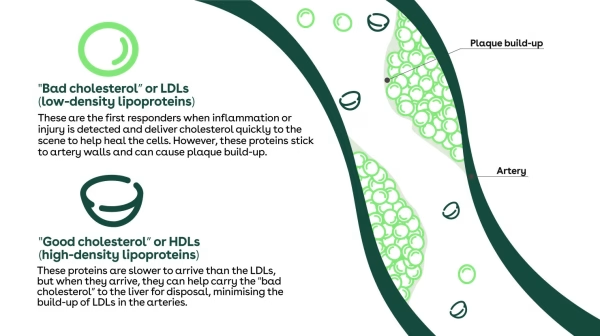What is a healthy cholesterol level?
Everything you need to know about cholesterol levels


Most of us have heard the message that high cholesterol is bad for us, but how many of us actually know what cholesterol is, and why a high count is a problem? The answer is probably not many and for those of us who do, it’s likely we’ve been misled.
Almost a decade ago, two major health campaigns urged Aussies to test their cholesterol levels with the aim of cutting their risk of developing serious heart conditions. One was Test the Nation, sponsored by a company who just happened to be spruiking a cholesterol-lowering margarine. The second, sponsored by another company with their own cholesterol-lowering products, provided alarming statistics around cholesterol, heart attacks and stroke in an attempt to promote its own products.
A review in the Medical Journal of Australia found that both campaigns were problematic for several reasons, the first being the confusion created around cholesterol being ‘bad’, which is not entirely accurate.
These brands also muddied the waters around who needs to be worried about their cholesterol and when testing is recommended. Current Aussie guidelines recommend testing if your GP has concerns about your risk of heart disease or every five years for people who are over 45 or who have high blood pressure or diabetes.

What is cholesterol?
Cholesterol is an essential type of fat carried in the blood, according to nutritionist Rachel Favilla.
“All cells in our body need cholesterol, and it has other important roles including maintaining the health of our nerve cells, synthesising vitamin D and producing some hormones – think testosterone, oestrogen and progesterone, and stress hormones including cortisol.”
Cholesterol is so essential to our health and wellbeing that our body produces around three quarters of what’s required in the liver and the rest comes from food. As Rachel explains, there are two distinct types of cholesterol.
“Fats, including cholesterol, combine with proteins to form lipoproteins which are carried through the bloodstream to where they’re needed. These come in two types - Low-Density Lipoproteins (LDLs) and High-Density Lipoproteins (HDLs).”
She says they’re often referred to as ‘good’ and ‘bad’ cholesterol, which isn’t quite correct.
“I describe them as helpers at the scene of an emergency. When inflammation or injury is detected, the LDL runs in as the first responder. Its role is to deliver cholesterol required for healing the cells.”
The reason it has a bad wrap is that LDL can deposit cholesterol into your artery walls if it’s not removed in a timely manner. This restricts blood flow by taking up space that could otherwise serve as a large passageway for efficient blood and nutrient exchange.
Meanwhile, Rachel says HDL is known as the ‘good’ cholesterol as it assists with the removal of LDL deposits in our arteries, zooming them off to the liver where around half – sometimes more – are recycled. So while high numbers of LDL are dangerous for your health, low counts of HDL are too.
There’s also a third player in the mix, triglycerides, which are another form of fat in the blood that can also raise the risk of heart disease; and the Heart Foundation notes that high triglycerides are often associated with low HDL cholesterol.
Normal cholesterol range in Australia
High cholesterol carries no signs or symptoms, and you’ll need a blood test to diagnose it. As a guide, health authorities recommend cholesterol levels should be no higher than 5.5 mmol per litre if there are no other risk factors present, or LDL levels less than 2 mmol/l for those who smoke, have high blood pressure or pre-existing heart disease.
According to the Australian Bureau of Statistics, 6.1% of all Australians (1.5 million people) had high cholesterol in 2017-18, a decline from 7.1% in 2014-15, and we fall into the middle rankings compared to other countries.
Tips to reduce cholesterol levels
Various factors affect blood cholesterol levels, including your diet and lifestyle, body weight and genes. Rachel has these tips for reducing cholesterol (though you should consult with your GP if you have any concerns – genetic issues, for example, may require medication).
Eat a healthy, varied diet
“Go for antioxidant-rich foods to help reduce inflammation in the body. Load up on veggies and don't be afraid to include some fruit – natural sugars are processed differently to refined varieties. Nuts, seeds, legumes and wholegrains are also brilliant”
Embrace omega 3 fatty acids
These can come from oily fish such as salmon or plant sources such as chia seeds, inca inchi seeds, flaxseeds (also called linseeds) and walnuts
Learn to love monounsaturated fats
Whether it’s from olive oil, avocado, peanuts, almonds, pecans or macadamias; these foods help boost HDL and lower LDL
Include fibre
Fibre can bind to excess cholesterol and remove it from circulation. Oats and barley are brilliant (try sourcing some organic sourdough oat or barley bread) as are legumes (lentils, beans and peas) and cruciferous veggies such as cauliflower, Brussels sprouts, broccoli and cabbage
Give yoga a whirl
Yoga is a gentle exercise that lowers stress levels by regulating heart rate, breathing rate and supporting the synthesis of neurotransmitters that calm the body down. This in turn lowers cortisol and inflammation – two big culprits of higher than normal cholesterol levels
Limit highly processed foods, trans fats, hydrogenated oil and refined sugars
These can be found in packet biscuits, cakes, pastries and deep fried foods, for example
Keen to learn more about how you can lower your cholesterol? Check out our article Heart disease prevention: The health benefits of a Mediterranean diet.
Getting headaches? Here’s what you need to know about eye strain
Here are some tips on relieving your eye strain symptom from an optometrist.
8 healthy habits to start in your 30s
It's the perfect time to lay the foundations of good health
8 ways to keep healthy in your 40s
Ditch the diet and start making some simple life changes





